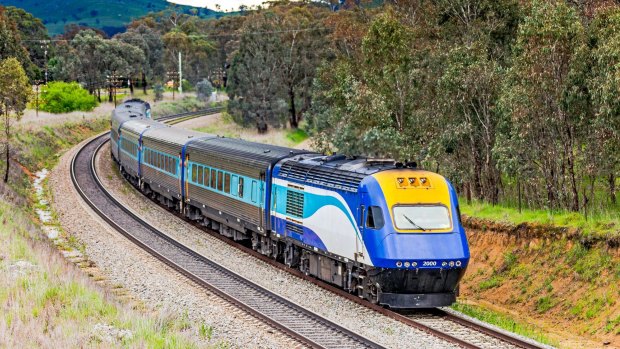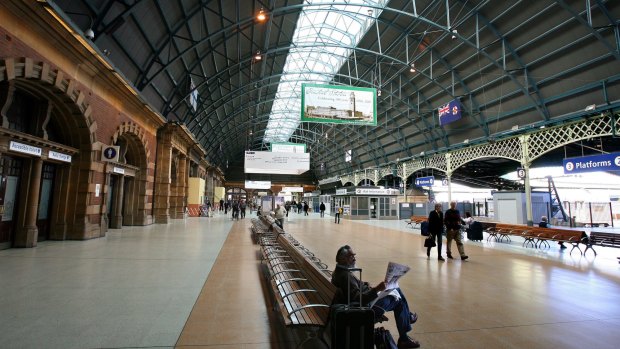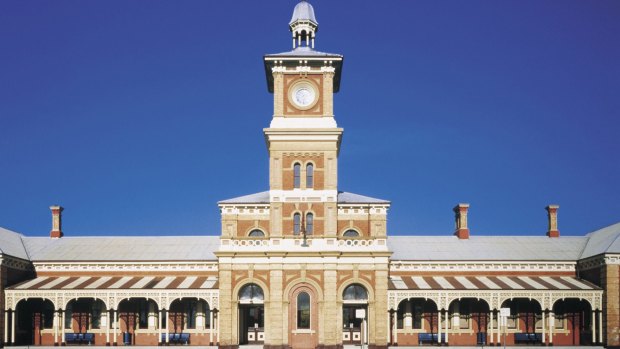This was published 2 years ago
Overnight train from Sydney to Melbourne: What it's like on board the XPT
By Tim Richards

The XPT train from Sydney to Melbourne.Credit: iStock
Australia is a land of epic train journeys that crisscross the nation from coast to coast. In this extract from his new book, Traveller contributor Tim Richards details his (pre-lockdowns) journey from Sydney to Melbourne.
The Grand Concourse at Sydney's Central Station was everything I wanted for the start of a long train journey. Opened in 1906, the concourse is a lofty space with a curved roof, walls of brick and stone, and stained-glass windows. It's a sweeping statement of confidence in railways, down to the bust and plaque honouring nineteenth-century engineer John Whitton as 'the father of the New South Wales railways.'
Central Station was a terminal built for grand journeys, for desperate missions, for tearful goodbyes by loved ones waving lace hankies as they ran alongside departing trains. The only thing missing was a suitably portentous place to eat, though a sign featuring photos of old station dining rooms promised 'A new dining experience, coming soon!'

The Grand Concourse at Sydney's Central Station.Credit: Bob Pearce
Whatever emerged from that redevelopment would be a vast improvement on the refreshment facilities at the original Sydney Terminal, built to serve the colony's first railway line which opened to Parramatta in 1855. That station, between where Central and Redfern stations stand today, was an embarrassingly humble iron structure within which one Henry Dudley leased a room from which to provide refreshments in 1856.
Unfortunately, the authorities had forbidden the operation of stoves within the building, so Dudley thought laterally and established a refreshment tent nearby. Dudley had evidently been cursed by the catering gods, as his tent was repeatedly set alight by sparks from passing steam locomotives, and was occasionally toppled by high winds.
In 1857 he was given permission to erect a simple iron building at the Chippendale entrance to the station, which must have seemed a great improvement on the tent. This new structure was promptly damaged by a storm.

Albury-Wodonga's impressive train station.Credit: Tourism NSW
When the line was extended to Campbelltown, the first extension to be overseen by our boy John Whitton, Dudley hoped the increase in passenger traffic would finally lead to healthy profits. On the opening of the line, however, the fares increased considerably, causing travellers to cut back on tea and pies.
The land around his building was then leased to timber merchants, who surrounded it with a fence, leaving it poorly ventilated. Dudley accepted the decrees of fate and abandoned his doomed business in 1859, later seeking compensation from parliament. The first attempt to refresh the rail travellers of Sydney had not ended well.
Above the concourse hung a clock with Roman numerals, next to a large departure board with screens divided into suburban, intercity and regional services. On the final screen was listed '20.42 Melbourne'.
On the platform I found a large plaque erected in 1970, when Sydney and Perth were joined for the first time by a single standard-gauge train. How glorious the rail future must have looked back then, when cross-country airfares were still dauntingly expensive.
Across the platforms, I could see each had a hanging sign saying 'CENTRAL' in large block letters. They stretched out like an optical illusion, one behind the other. It was a still, humid evening on Platform 1. Anticipation hung in the air, as if fate was about to deliver something special.
What it delivered was Mr Singh.
I met him the moment I stepped into our cabin, in which he had drawn the top berth. 'I travel down to Melbourne every three months,' said my travel mate. 'I live right here next to Central Station, so it's easier than flying.'
Mr Singh was originally from Punjab in India, and worked as a migration agent. I had guessed he was a regular, as the attendant who'd taken our breakfast orders had recognised him.
The complimentary breakfast supplied to sleeper passengers was fairly basic, but you got to choose your spreads. I went for Vegemite.
'Ah, you are Australian,' said the attendant, who I guessed was also from India.
The two-berth compartment, technically known as a twinette, was the same as the one I'd sat in from Brisbane, but the night-time experience was different. Mr Singh and I each had a pile of plastic-wrapped items stacked on the middle seat: a snack pack, a toiletries bag and a towel.
Later the berths would be folded down, and the shower within the adjacent bathroom could be used. Unlike my Brisbane-to-Sydney jaunt, there would be little scenery to enjoy on this trip. It was already dark when we left Central, and the only brightly lit places that could be discerned through the reflective windows were the suburban stations we passed: Redfern, Sydenham, Wolli Creek.
Occasionally we'd pass a two-deck Sydney train running along a parallel track. They weren't very full this late on a weekday. I could see people reclining, reading, thumbing their phones. I wondered idly who they were, where they were heading, what they'd be doing when they got there, what they'd be having for dinner, when our trains diverged and they passed out of my life.
I opened the plastic snack pack. Inside it was the following: popcorn, biscuits, water, a mint, crackers and chutney.
It was odd eating a sachet of chutney with crackers but without cheese, and there were only two crackers so some chutney was left over. Perhaps cheese had been the victim of a budget cutback.
By mutual agreement, Mr Singh and I asked the attendant to put the beds down at about 9.30 pm, after we'd dutifully munched our way through the snack packs.
It was difficult to sleep, though Mr Singh seemed to be managing it. He was very quiet, not a snorer. On this train I was lying perpendicular to the train's direction of motion, which meant a lot of rocking – and not like that of a cradle, more a washing machine.
As a result I tossed and turned, trying to find the ideal position and never quite managing it. I felt like I hadn't slept at all, then I looked at my phone at one point and it was 4 am. We were about to arrive at Albury.
I dressed and wandered down the train to the cafe, through the first-class seated area. In the darkened carriage the sleeping passengers looked as if they'd been the victims of a terrible plague, their bodies arranged at grotesque angles.
The train stopped and, coming across an open door, I stuck my head out to view the long colonnaded platform at Albury Station. For a regional station, Albury is rather magnificent – a colonial-era edifice with a clock tower, verandahs decorated with iron lace and waiting rooms with arched windows and high ceilings. Its platform is equally spectacular. At 455 metres long, when it opened in 1883 it was the longest in Australia. Covered by a long colonnade of Grecian pillars supporting a metal roof, it's still an attractive place to board or alight.
The reason for this splendid platform was, of course, the gauge problem. From 1881, when the New South Wales railway line first reached Albury, passengers had to transfer between Albury and Victorian Wodonga via stagecoach. Then in 1883, Victoria's broad-gauge North East line was extended across the Murray River to meet New South Wales' standard-gauge Main Southern line at Albury.
It's hard to imagine the excitement that at the time was stirred by the opening of a railway line, now that trains are a daily convenience and aircraft a useful nuisance. But the meeting of these lines was a very big deal indeed. The official record of the event, snappily titled The Union of the Railway Systems of New South Wales and Victoria, sets the scene:
On the day of opening, the border towns of Albury and Wodonga were astir from an early hour. The special trains from Sydney were loaded with passengers, and the traffic between Albury Station and the various hostelries, to which the travellers drove immediately on their arrival, gave to the streets an appearance of activity and excitement which they never before assumed. Lines of flags and banners were stretched across the principal streets … The railway station, an exceedingly handsome structure, was decorated most lavishly with bunting; festoons of evergreens were hung along the platform front, and the supporting pillars of the verandah. Poles bearing huge flags of different nations were erected … In short, advantage was taken of every point where decorations of any kind could be displayed.
A public holiday had been declared in Albury for the opening, which was officiated over by the colony's governor, Lord Loftus. Bands played, an address of welcome was read out by earnest local councillors to the governor, and in the mid-afternoon a train from Melbourne crossed the Murray River to deliver his Victorian counterpart, the Marquess of Normanby. Quite the gathering of toffs.
As for literary royalty, the great American author Mark Twain had passed through here by rail. In his 1897 travelogue Following the Equator, he marvelled at the lunacy that had created such an inconvenience as a break of gauge between Australia's two greatest cities:
Now comes a singular thing: the oddest thing, the strangest thing, the most baffling and unaccountable marvel that Australasia can show. At the frontier between New South Wales and Victoria our multitude of passengers were routed out of their snug beds by lantern-light in the morning in the biting-cold of a high altitude to change cars on a road that has no break in it from Sydney to Melbourne! Think of the paralysis of intellect that gave that idea birth; imagine the boulder it emerged from on some petrified legislator's shoulders.
Beyond the platform was a short section of disused broad-gauge track which had been left in place, as an exhibit of rail gauge folly. The train quietly pulled out, and a few minutes later we were crossing the Murray River, invisible beneath us in the dark. I was back in Victoria. Returning to my berth, I napped. The next time I checked the time it was nearly 6 am, and still pitch-black outside. I followed my 'hit the showers first' policy and dressed, wondering idly when I could ask Mr Singh to reinstate the lounge in place of the berths.
A knock on the door heralded the first instalment of breakfast. The XPT catering department continued its mix of old school and plain odd, by producing a plastic bowl of cornflakes with peel-off lid, a small carton of milk and a spoon whose bowl was the size of a thumbnail. Together they constituted an IQ test, to be passed by not spilling anything on oneself.
The second instalment was a box containing two slices of white toast, Vegemite, butter and a cup of hot water with supplied coffee bag. Attempting to consume any of this while lying in my berth was tricky. The cornflakes alone were a minefield. After I'd eaten as much as I could manage, I realised I could restore the lounge seat without disturbing Mr Singh, by levering up my berth alone. He was happily seated cross-legged on his berth, the old hand, eating his toast like a pro.
The sun finally rose to reveal a cloudy day. A train operated by V/Line, the state railway company, played hopscotch with us on a parallel track as we approached Melbourne's outskirts. It was filthy, and packed with long-distance commuters heading to the city. At Roxburgh Park, one of Melbourne's outer suburbs, a huddle of people was waiting for a local train to work. One of the traveller's greatest pleasures is watching other people go to their nine-to-five jobs while you're not.
We slid through the industrial backblocks of Melbourne, across the Maribyrnong River, past towering stacks of shipping containers. I had my first sighting of a tram as it crossed the La Trobe Street bridge.
As we passed the glass-and-steel architectural fancies that were the new office buildings of Docklands, I asked Mr Singh why he really took the train rather than flew. Was he afraid of flying?
'No. If I fly, I wouldn't get to my Melbourne office before noon. This way I'm there when it opens. I like to be on time.'
That was more than could be said of this train, which was running half an hour late.
'Perhaps I'll get to the office at nine-thirty today, rather than nine,' allowed Mr Singh. He had a certain degree of flexibility after all.
This is an edited extract from the book Heading South: Far North Queensland to Western Australia by Rail by Tim Richards (Fremantle Press 2021). Heading South (RRP $29.99) is available in all good bookstores and online. See https://www.fremantlepress.com.au/products/heading-south
Sign up for the Traveller Deals newsletter
Get exclusive travel deals delivered straight to your inbox. Sign up now.